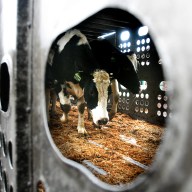 Swatilekha Sengupta plays a wife caught between two men in Satyajit Ray’s “The Home and the World.”
Swatilekha Sengupta plays a wife caught between two men in Satyajit Ray’s “The Home and the World.”
Credit: The Criterion Collection
Late Ray
The Criterion Collection
$44.95
Bollywood has long been all most Westerners know of Indian cinema — that and perhaps the work of Satyajit Ray, the nation’s most esteemed filmmaker. There’s much, much more to see — but then, there’s even more to Ray himself than most know. A renaissance man who also wrote books and music, including the scores to many of his films, he’s best known for his initial, intimate studies of Bengali life, including “The Apu Trilogy,” “Devi” and “Charulata.” Less talked about are his latter day works before his 1992 death, including the three collected in the Criterion Collection’s budget-priced Eclipse box “Late Ray.”
All three are films by a lifelong humanist who only become more fascinated with people the older he got. Ray first purchased the rights to “The Home and the World,” Rabindranath Tagore’s 1916 novel, well before his landmark first feature, 1955’s “Pather Panchali.” But his first attempt to film it failed, which he counted as lucky as the script was, he felt, simplistic and Hollywoodesque. It’s an older artist’s novel anyway, and by 1984 Ray was suitably mature to handle the intellectual battle between a progressive landlord (Victor Banerjee, of “Passage to India”) and a fiery revolutionary (Ray regular Soumitra Chatterjee). The latter has been touring the country, riling up the Hindu masses to demand an end to foreign imports, in an attempt to snub both British colonialists and more worldly-minded locals. That would include the former, an old college friend who not only wants India to join the world, but recognizes that his pal’s demands may lead to the suffering of the poor Muslim part of the population.
Caught in between is the former’s wife (Swatilekha Sengupta), who finds herself, like Ray, swinging between the two. Even when Ray ultimately picks a side, he acknowledges that neither is fully right. The topic of tradition versus progress is one that consumed Ray his entire life, and while he was definitely a man of forward-thinking, he knew that nothing was simple and that any steps in the right direction can result in unexpected, unintended problems.
“The Home and the World,” like the rest in the set, puts these thoughts right in the character’s mouths. These are, unusually for Ray, chatty films, in part because the filmmaker, then in his 60s, was succumbing to health problems. He suffered his first heart attack while making the film, thus restricting his movements and those of the camera. Forced to film (mostly) indoors and at a smaller scale, he tackled Henrik Ibsen’s “An Enemy of the People,” relocating it from 19th century Norway to modern day Bengal. The most significant change, though, is introducing religion into the equation. His version of Ibsen’s righteous but stubborn hero is a doctor (Chatterjee again) who’s found the holy water at a small town’s popular temple is fatally tainted. He’s shellshocked when he receives severe push-back from fundamentalists, including his ascot-wearing businessman brother (Dhritiman Chatterjee, who also stands out in the set’s third film, “The Stranger”).
It’s disarming seeing a filmmaker known for rapturous, black-and-white mood pieces — including 1958’s “The Music Room” — take a turn for the talky. But Ray’s direction is deceptively plain here and in his swan song, 1991’s “The Stranger,” an original story inspired by his own life, about an elusive wanderer (Utpal Dutt) who shows up after decades abroad at a relative’s home. The family suspects he may be an imposter begging for money, but the drama that results is more modest and more thoughtful.
Dutt’s man of mystery describes himself as both “omnivorous” and having “a small appetite.” That describes the film, which features only a handful of people and scenes yet thematically explores all of modern India, plus humanity in general. If Ray’s camera here is usually (though not always) locked down, focused on the simple act of people talking, the ideas and his understanding and love for humanity are boundless.
Also out:
‘Archer’: The Complete Season Four
The other unspeakably brilliant animated comedy with a lead voice by H. Jon Benjamin, this ostensible spy romp found world’s colliding in its last season, with some crossover with “Bob’s Burgers,” plus a walk-on from another culinary genius, Anthony Bourdain.
‘The Wicker Man’: The Final Cut
Hopefully the stink from the laughable Nicolas Cage-Neil LaBute remake of this English cult object has dissipated, leaving you free to realize how weird it is. Robin Hardy’s thriller-horror (and sometime musical) finds a detective snooping around an island overrun by a backwards religious sect, fending off Christopher Lee, a naked Britt Eckland and a shocking capper.
‘Duck Dynasty’: Season Four
Great timing! This set will no doubt the already bursting-at-the-seams pockets of a homophobe and racist. On the bright side, maybe he’ll use them to buy a better education.
















